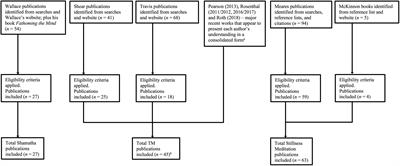Silence in Shamatha, Transcendental, and Stillness Meditation: An Evidence Synthesis Based on Expert Texts
Shamatha, Transcendental, and Stillness Meditation are said to aim for “contentless” experiences, where mental content such as thoughts, perceptions, and mental images is absent.

Silence is understood to be a central feature of those experiences. The main source of information about the experiences is texts by experts from within the three traditions. Previous research has tended not to use an explicit scientific method for selecting and reviewing expert texts on meditation. We have identified evidence synthesis as a robust and transparent method that is suitable for this purpose. In this paper we use evidence synthesis based on expert texts to examine silence/quietness as a feature of the contentless experiences in the three practices. Objective criteria were used to select a sample of 135 expert texts. A database containing the expert descriptions of the meditation techniques and experiences was produced by extracting the relevant material from the publications and coding that material to differentiate individual features. The database, which forms part of the supplementary material for this paper, identifies each feature of the contentless experiences referred to in the expert texts, including silence/quietness. Our key finding is that the experts indicate silence/quietness has a particular connection with stillness, and the absence of concepts, mental activity/noise, thoughts, and disturbance. Further analysis leads to the following insights. The silence/quietness reflects the absence of thoughts and sounds, and this fits neatly with a conception of silence/quietness as the absence of internal and external noise. In some cases the terms silence and quietness may also reflect the absence of other disturbances such as non-auditory perceptions, mental images, and negative feelings. That would fit with a conception of silence/quietness as complete calm or absence of disturbance. It is not clear from the expert texts how silence/quietness is distinct from other features such as stillness that also reflect the absence of disturbances. As a separate matter, silence/quietness has connections with all the other features of the contentless experiences, but the closeness of the connections varies. Our work uncovers fine distinctions and ambiguities which lead to new research questions that can be explored in future studies. .
Read the full article at the original website
References:
